The kitchen countertop serves as the heart of our culinary space and significantly impacts both functionality and aesthetic appeal. We’ve all experienced that moment when we walk into a kitchen and immediately notice whether the countertops elevate or diminish the entire room’s design.
Choosing the right countertop material can transform our cooking experience while adding substantial value to our homes. From timeless granite and elegant quartz to trendy butcher block and sleek concrete options we’ll explore materials that suit every budget and lifestyle.
We understand that selecting kitchen countertops involves balancing durability maintenance requirements and visual impact. That’s why we’ve compiled the most innovative and practical countertop ideas that’ll help you create a space you’ll love for years to come. Whether you’re planning a complete kitchen renovation or simply updating your surfaces these countertop answers will inspire your next project.
Timeless Granite Kitchen Countertops Ideas for Classic Elegance
Granite remains the gold standard for homeowners seeking kitchen countertops that combine durability with sophisticated beauty. We’ll explore how this natural stone continues to define luxury in kitchen design through its rich patterns and enduring appeal.
Popular Granite Colors and Patterns
Black granite varieties dominate luxury kitchen designs with their dramatic visual impact and versatility. Galaxy Black showcases stunning silver speckling that catches light beautifully, while Absolute Black provides a sleek, uniform surface perfect for contemporary spaces. Verde Peacock brings deep forest tones with intricate veining patterns.
White and light granite options create bright, airy atmospheres that make kitchens feel more spacious. Kashmir White features subtle gray veining with cream undertones, making it ideal for traditional and transitional designs. Colonial White offers clean backgrounds with minimal pattern variation, perfect for showcasing colorful backsplashes or cabinetry.
Beige and brown granite selections provide warm, inviting surfaces that complement wood elements beautifully. Giallo Ornamental displays golden yellows with burgundy and gray flecks, creating movement across the surface. Santa Cecilia combines cream backgrounds with rich brown and gold minerals for timeless appeal.
Exotic granite patterns serve as stunning focal points in kitchen designs. Blue Pearl features iridescent blue crystals that shimmer against dark backgrounds, while Labradorite displays dramatic color shifts from gray to blue depending on lighting angles. These premium options typically cost 20-30% more than standard varieties.
Maintenance Tips for Granite Surfaces
Daily cleaning routines keep granite surfaces looking pristine with minimal effort required. Use warm water and mild dish soap for regular cleaning, avoiding acidic cleaners like vinegar or lemon juice that can etch the surface. Microfiber cloths prevent scratching while effectively removing residue and water spots.
Sealing schedules protect granite from stains and maintain its natural luster over time. Most granite surfaces require resealing every 12-18 months, though some dense varieties like Absolute Black may need sealing less frequently. Test your granite by placing a few drops of water on the surface; if absorption occurs within 15 minutes, resealing is necessary.
Stain removal techniques address common kitchen spills before they become permanent marks. Oil-based stains respond well to baking soda poultices left overnight, while organic stains from coffee or wine need hydrogen peroxide treatment. Heat damage from hot pots rarely affects granite, but using trivets prevents potential thermal shock in extreme cases.
Preventive measures extend granite lifespan significantly beyond the typical 20-year expectation. Place cutting boards over granite surfaces to prevent dulling your knives rather than damaging the stone. Clean spills immediately, especially from acidic substances like citrus juice or wine that can cause etching on softer granite varieties.
Cost Considerations for Granite Installation
Material pricing tiers vary significantly based on granite origin and rarity factors. Level 1 granites like Tan Brown or Baltic Brown cost $40-60 per square foot installed, while Level 2 options such as Kashmir White range from $60-80 per square foot. Exotic Level 3 granites like Blue Bahia can reach $80-120 per square foot due to limited availability.
Installation factors significantly impact total project costs beyond material expenses. Edge treatments add $10-30 per linear foot, with ogee and bullnose profiles being most popular. Cutouts for sinks and cooktops typically cost $100-200 each, while backsplash integration adds $15-25 per square foot.
Regional cost variations affect granite pricing across different markets substantially. Metropolitan areas generally see 15-25% higher installation costs due to labor expenses and transportation factors. Rural locations may have limited granite selection but often feature lower installation rates from local contractors.
Budget planning strategies help homeowners maximize value while achieving desired aesthetics. Consider Level 2 granite options that offer beautiful patterns at moderate prices, or select remnants for smaller projects like islands or bathroom vanities. Timing installations during slower seasons can yield 10-15% savings from contractors seeking steady work.
Modern Quartz Kitchen Countertops Ideas for Contemporary Homes
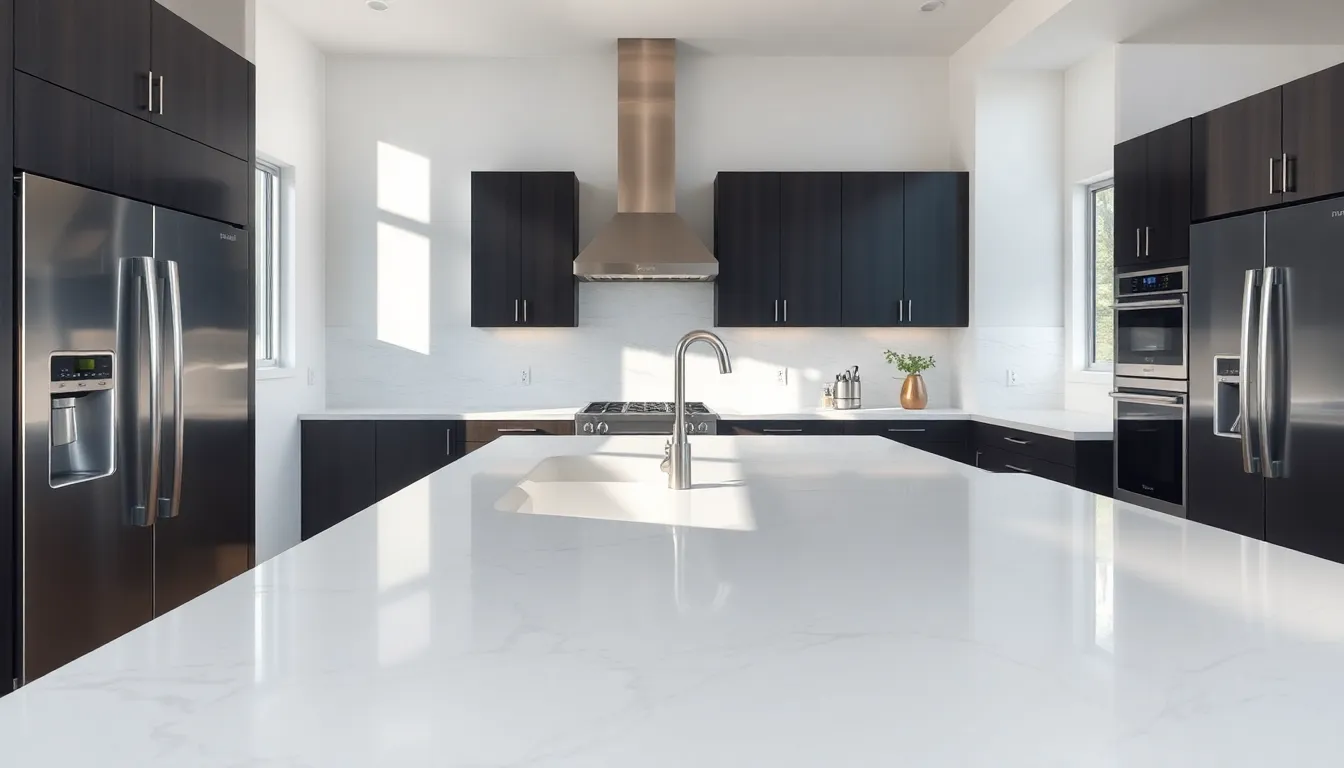
Engineered quartz represents the perfect fusion of natural beauty and cutting-edge technology for today’s contemporary kitchens. We’ve seen this innovative material transform countless culinary spaces with its versatility and performance.
Benefits of Engineered Quartz Materials
Durability stands as the primary advantage of engineered quartz countertops, offering exceptional resistance to scratches, heat, and stains that makes them ideal for busy kitchens. We appreciate how these surfaces maintain their pristine appearance even under heavy daily use.
Maintenance requirements remain minimal compared to natural stone alternatives since quartz’s non-porous surface prevents bacteria growth and eliminates the need for regular sealing. Cleaning becomes effortless with just soap and water for daily upkeep.
Versatility in design options allows engineered quartz to mimic various natural stone patterns while providing consistent coloring and veining throughout each slab. We find this predictability particularly valuable for large kitchen installations where pattern matching matters.
Color Options and Design Flexibility
Neutral tones dominate the popularity charts with white, gray, and black quartz leading contemporary kitchen designs across various architectural styles.
White quartz delivers a clean and timeless aesthetic that brightens spaces while featuring subtle veining patterns that add visual depth without overwhelming the design. We recommend pairing white quartz with darker cabinetry for striking contrast.
Gray quartz offers sophisticated versatility available in light, medium, and dark shades that complement both warm and cool color palettes in modern kitchens. These tones provide the perfect backdrop for stainless steel appliances and contemporary fixtures.
Black quartz adds dramatic luxury to kitchen spaces, often incorporating sparkle elements or natural-looking veining that creates stunning focal points. We’ve seen black quartz paired beautifully with white cabinetry for bold contemporary statements.
Bold color choices like blue quartz provide unique design opportunities for homeowners seeking distinctive kitchen personalities that stand apart from traditional neutral schemes.
Durability and Stain Resistance Features
Stain resistance capabilities excel due to quartz’s non-porous engineered surface that prevents liquids from penetrating and causing permanent discoloration. We find this particularly beneficial for families with active cooking routines.
Heat resistance properties withstand moderate temperatures from hot cookware, though we recommend using trivets for extremely hot items to preserve the surface integrity over time.
Scratch resistance ensures longevity through engineered quartz’s hardness rating that surpasses many natural stone alternatives, maintaining smooth surfaces even after years of knife work and food preparation activities.
Luxurious Marble Kitchen Countertops Ideas for Sophisticated Spaces
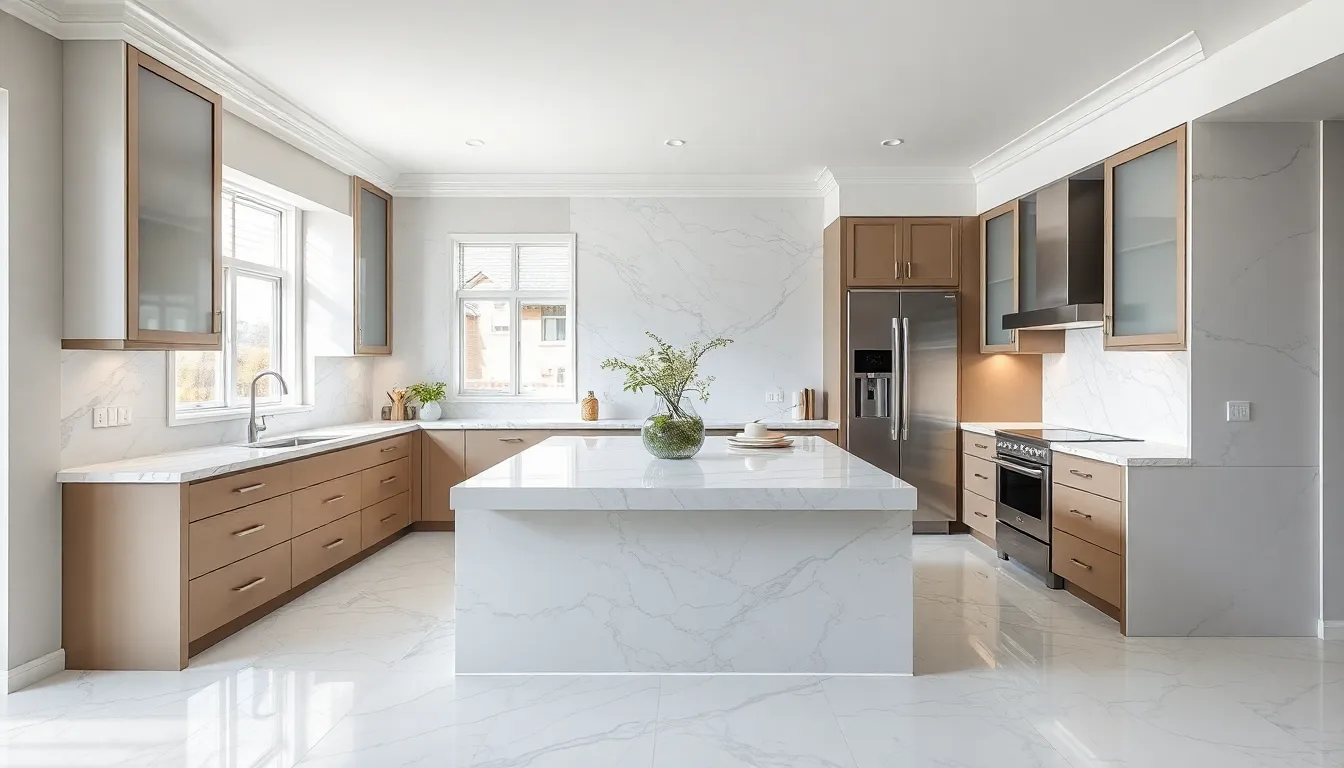
We find marble countertops deliver unmatched elegance and sophistication that instantly transforms any kitchen into a luxurious culinary haven. These natural stone surfaces bring timeless beauty and exceptional character to sophisticated spaces.
Carrara vs. Calacatta Marble Varieties
Carrara marble stands out with its softer veining patterns and pristine white background, creating a subtle yet refined aesthetic perfect for minimalist kitchen designs. We often recommend this variety for homeowners seeking understated elegance without overwhelming visual elements.
Calacatta marble features dramatically bolder veining with a creamier background tone that adds luxurious impact to any space. This premium variety commands attention through its striking patterns and serves as a stunning focal point in sophisticated kitchens.
Classic white marble with gray veins offers versatility in both Carrara and Calacatta options, providing bright and clean aesthetics with distinctive sophistication levels. We see these varieties complement various cabinet styles while maintaining their timeless appeal.
Bold black marble creates dramatic contrast when paired with lighter cabinetry and fixtures, adding depth and visual interest to contemporary kitchen spaces. This striking option works exceptionally well in modern designs seeking sophisticated drama.
Honed marble finishes deliver soft and matte surfaces ideal for those preferring less reflective countertops in contemporary and minimalist kitchen designs. We appreciate how this finish reduces glare while maintaining marble’s natural beauty.
Sealing and Care Requirements
Regular sealing protects marble countertops against stains and maintains their pristine appearance over time. We recommend professional sealing every 12 to 18 months depending on usage frequency and marble variety.
Mild soap and water provide the safest cleaning method for daily maintenance of marble surfaces without causing damage or dulling. We always advise avoiding harsh chemicals that can etch or discolor these natural stone countertops.
Immediate spill cleanup prevents staining and maintains marble’s luxurious appearance throughout years of kitchen use. We stress the importance of wiping acidic substances like lemon juice or wine immediately to prevent permanent etching.
pH neutral cleaners specifically designed for natural stone offer the best protection while maintaining marble’s natural luster and beauty. We recommend these specialized products over generic household cleaners for optimal results.
Design Applications for Marble Surfaces
Waterfall edge countertops showcase marble’s natural beauty by extending the stone down island or peninsula sides for dramatic visual impact. We love how this design element creates seamless transitions while highlighting marble’s unique veining patterns.
Marble backsplashes provide unified elegance when paired with matching countertops, creating cohesive and sophisticated kitchen designs throughout the space. This application maximizes marble’s visual impact while protecting walls from cooking splashes.
Central island applications allow marble to serve as the kitchen’s focal point while providing functional workspace for food preparation and casual dining. We often design these islands to complement surrounding cabinetry while showcasing marble’s natural beauty.
Floor integration creates unified and elegant looks throughout kitchen spaces when marble extends from countertops to flooring surfaces. This comprehensive approach delivers sophisticated continuity that elevates the entire culinary environment.
Budget-Friendly Laminate Kitchen Countertops Ideas for Smart Savings

Laminate countertops offer an excellent alternative to expensive natural stone surfaces without sacrificing style or functionality. We’ve discovered that modern laminate options provide remarkable value while delivering sophisticated aesthetics that rival premium materials.
High-Quality Laminate Options Available
Durability standards have significantly improved in today’s laminate countertops, with modern materials offering enhanced resistance to scratches and stains compared to older versions. Leading manufacturers like Formica and Wilsonart produce high-quality laminate surfaces that combine affordability with visual appeal, making them ideal for budget-conscious renovations.
Color variety spans an impressive range, from subtle neutrals to bold statement hues that complement any kitchen design aesthetic. Popular patterns include granite-inspired speckles, marble-like veining, and solid colors that create clean, contemporary looks.
| Brand | Price Range | Popular Patterns | Warranty |
|---|---|---|---|
| Formica | $15-$40 per sq ft | Granite, Marble, Solid | 10 years |
| Wilsonart | $18-$45 per sq ft | Stone, Wood, Abstract | 15 years |
| Pionite | $12-$35 per sq ft | Natural, Metallic, Textured | 8 years |
Performance features in premium laminate options include antimicrobial surfaces, enhanced scratch resistance, and improved heat tolerance that makes them suitable for active kitchen environments.
Installation Methods and Techniques
Preparation work begins with ensuring cabinets are perfectly level and surfaces are thoroughly cleaned and dried before installation. We recommend checking for any irregularities that could affect the final appearance of your laminate countertops.
Adhesive application requires contact cement applied to both the laminate backing and the countertop surface, allowing each layer to become tacky before joining. This critical step ensures maximum bonding strength and prevents future lifting or bubbling.
Installation process involves carefully positioning the laminate sheet and applying consistent pressure with a roller to eliminate air bubbles and create a strong, permanent bond. Professional installers often use specialized tools to achieve seamless edges and perfect alignment.
Trimming techniques include using sharp carbide-tipped router bits to create clean, precise edges that enhance the overall finished appearance. We’ve found that proper edge treatment significantly impacts the perceived quality of laminate installations.
Creative Patterns and Textures
Stone effects in laminate countertops convincingly replicate natural granite, marble, and quartz surfaces at a fraction of the cost. Modern printing technology creates depth and realistic variations that make these surfaces nearly indistinguishable from authentic stone.
Wood grain patterns offer warmth and natural beauty, with options ranging from light oak to rich walnut finishes that complement both traditional and contemporary kitchen designs. These wood-look laminates provide the aesthetic appeal of butcher block without the maintenance requirements.
Metallic accents add contemporary flair through subtle shimmer effects and bold metallic finishes that create striking focal points. Popular options include brushed aluminum, copper, and stainless steel looks that coordinate with modern appliances.
Custom design possibilities emerge through creative cutting and shaping techniques that allow for unique patterns, inlays, and decorative elements. We’ve seen homeowners create geometric designs, contrasting borders, and even incorporate company logos or family crests into their countertop surfaces.
Textured surfaces provide tactile interest through embossed patterns that mimic natural stone textures, leather finishes, and even fabric-inspired designs that add dimensional depth to kitchen spaces.
Rustic Butcher Block Kitchen Countertops Ideas for Warm Appeal
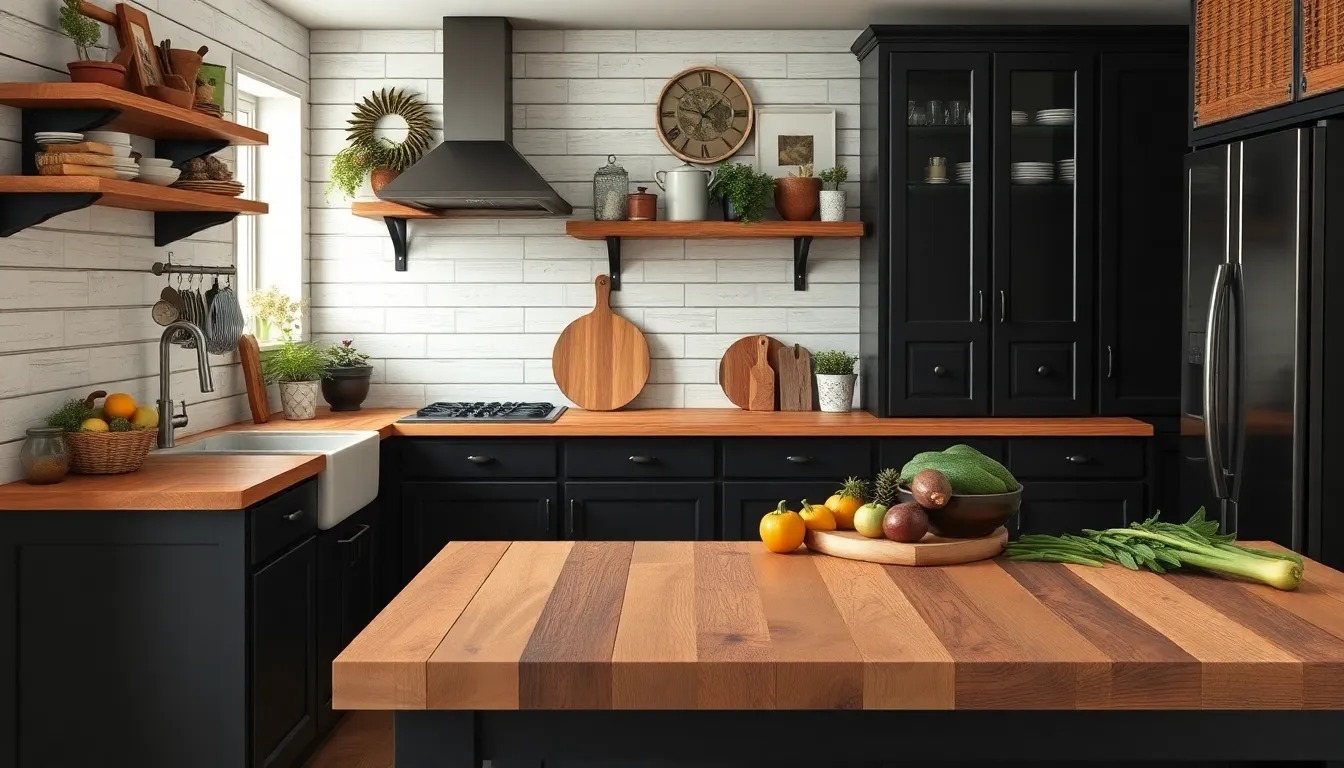
We can transform our kitchen into a cozy sanctuary with butcher block countertops that deliver natural warmth and timeless charm. Wood countertops offer an inviting alternative to stone surfaces while maintaining excellent functionality for daily cooking tasks.
Wood Species Selection Guide
Oak butcher block countertops provide exceptional durability with their light color tones that complement both rustic and modern kitchen designs. This popular wood species features subtle grain patterns that won’t overwhelm other design elements in our space.
Acacia wood surfaces deliver richer, darker tones with prominent grain patterns that create visual interest and texture. These exotic wood countertops work beautifully in traditional kitchen settings where we want to showcase natural wood character.
Walnut butcher block options offer sophisticated dark finishes that bring luxury to rustic kitchen designs. We’ll find walnut’s deep chocolate tones create stunning focal points while maintaining the warm appeal of natural wood.
| Wood Species | Color Tone | Grain Pattern | Best For |
|---|---|---|---|
| Oak | Light | Subtle | Modern rustic |
| Acacia | Dark/Rich | Prominent | Traditional |
| Walnut | Dark/Luxurious | Distinctive | Sophisticated rustic |
Proper Sealing and Maintenance Practices
Waterproof and food-safe sealers protect our butcher block countertops from moisture damage and staining that can occur during daily food preparation. We should apply these protective coatings immediately after installation to ensure maximum durability.
Regular oiling schedules maintain the wood’s natural beauty and prevent surface drying that leads to cracking or splitting. Monthly applications of mineral oil or specialized wood conditioners keep our countertops looking fresh and vibrant.
Fine grit sanding techniques restore scratched surfaces and remove minor damage from daily use. We can address surface imperfections with 220-grit sandpaper followed by proper resealing to maintain our countertops’ pristine appearance.
Integration with Farmhouse Design Themes
Shiplap wall combinations with black cabinetry create modern farmhouse aesthetics when paired with butcher block countertops. We can enhance this look by incorporating open shelving that showcases rustic dishes and vintage kitchen accessories.
Earthy color schemes featuring soft yellows and greens complement the natural wood tones in our butcher block surfaces. These warm hues create cohesive farmhouse environments that feel both comfortable and stylish.
Vintage hardware elements like antique-style pulls and distressed finishes unite with butcher block countertops to establish authentic farmhouse character. We’ll find that combining these traditional details with colorful accents creates inviting spaces perfect for family gatherings.
Industrial Concrete Kitchen Countertops Ideas for Urban Style
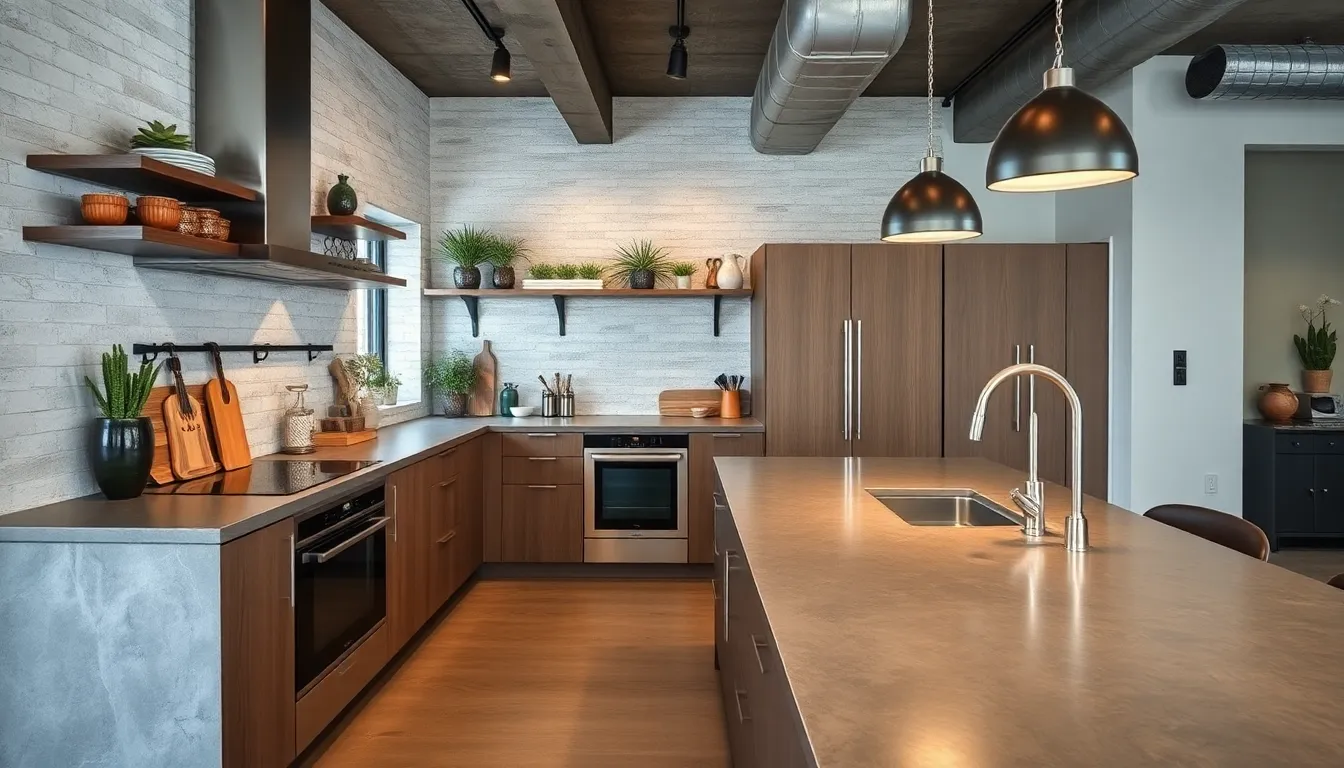
Industrial concrete countertops deliver raw aesthetic appeal that perfectly complements modern urban kitchen designs. These versatile surfaces offer countless customization possibilities through various finishes and textures like exposed aggregate or polished surfaces to enhance the industrial look.
DIY vs. Professional Installation Options
DIY Installation works best for smaller concrete projects but requires important experience with concrete work to prevent cracking and ensure proper sealing. Cost savings make this approach attractive, yet uneven finishes or structural issues often result when proper techniques aren’t followed.
Professional Installation guarantees polished finishes and long-term durability through specialized tools and expert techniques. Contractors prevent cracking while ensuring smooth, even surfaces that maintain their appearance over time. Investment in professional services typically pays off through superior results and reduced maintenance needs.
Customization Through Colors and Textures
Color Options transform concrete surfaces using integral pigments or surface treatments to match any urban aesthetic preference. Earthy tones like terra cotta or sand soften the industrial appearance, while darker colors enhance the raw, contemporary look. Neutral grays and charcoal blacks create sophisticated foundations for modern kitchen designs.
Texture Techniques add visual depth through exposed aggregate finishes that reveal natural stone elements within the concrete. Rough finishes create tactile interest while polished surfaces reflect light and create sleek, modern appearances. Stamped patterns can mimic other materials while maintaining concrete’s industrial character.
Durability and Long-Term Performance
Scratch and Heat Resistance make properly sealed concrete countertops excellent choices for busy kitchens that handle daily cooking activities. These surfaces withstand hot pots and sharp knives when maintained correctly through periodic resealing applications.
Maintenance Requirements include regular resealing to prevent stains and maintain appearance over time. Cracking can occur if installation isn’t done correctly or if the slab settles unevenly beneath the surface. Proper care ensures these industrial surfaces maintain their urban appeal for years while developing attractive patina that enhances their character.
Sleek Stainless Steel Kitchen Countertops Ideas for Professional Kitchens
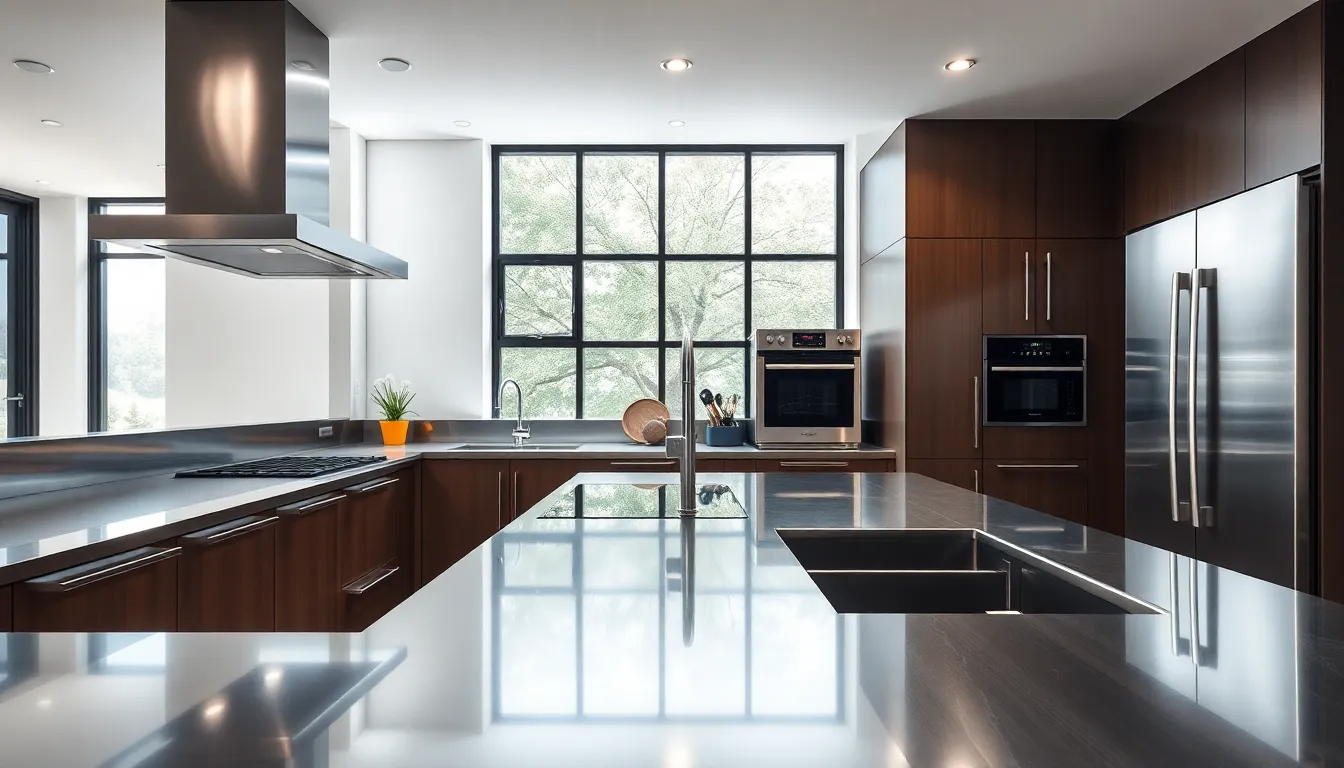
Stainless steel countertops represent the pinnacle of professional kitchen design, offering unmatched durability and functionality. We’ve seen these surfaces transform residential kitchens into chef-worthy spaces that rival commercial establishments.
Commercial-Grade Material Benefits
Durability stands as the primary advantage of stainless steel countertops, with 16-gauge commercial-grade steel providing exceptional resistance to chipping, scratching, and staining. Professional kitchens rely on this resilience to withstand high-traffic use and constant food preparation activities.
Hygiene becomes effortless with stainless steel surfaces, as they naturally resist bacteria and meet strict sanitation standards required in food service environments. We recommend stainless steel for homeowners who prioritize cleanliness and food safety in their cooking spaces.
Longevity characterizes heavy-duty stainless steel construction, with properly installed countertops lasting decades without important wear or degradation. Commercial kitchens choose this material specifically for its ability to maintain performance under demanding conditions.
Heat resistance allows stainless steel countertops to handle hot pots and pans directly from stovetops without damage or discoloration. This feature makes them ideal for serious home cooks who need worry-free workspace functionality.
Cleaning and Maintenance Requirements
Simple cleaning requires only a wet cloth and mild detergent to maintain stainless steel surfaces in pristine condition. We appreciate how this straightforward approach saves time compared to other countertop materials that demand specialized cleaners.
Avoiding acidic products prevents damage to stainless steel finishes, so we recommend steering clear of vinegar-based or citrus cleaners. Standard dish soap and water provide adequate cleaning power without compromising the surface integrity.
Treating scratches becomes manageable with products like Sidol applied in the direction of the steel’s brush pattern. Minor surface scratches can often be minimized or eliminated with proper polishing techniques and appropriate cleaning products.
Daily maintenance involves wiping surfaces dry after cleaning to prevent water spots and maintain the steel’s lustrous appearance. Regular care prevents buildup of fingerprints and maintains the professional look that makes stainless steel so appealing.
Design Integration with Modern Appliances
Seamless coordination occurs naturally when stainless steel countertops match existing appliances like refrigerators, ranges, and dishwashers. We’ve observed how this material choice creates visual continuity that enhances overall kitchen design cohesion.
Customization options include various sizes and configurations that accommodate any kitchen layout or design preference. Professional fabricators can create custom pieces with integrated sinks, backsplashes, and edge profiles to match exact requirements.
Modern aesthetic emerges from the clean lines and satin finish that complement contemporary kitchen styles and open floor plans. Stainless steel’s timeless appearance ensures it won’t become dated as design trends evolve over time.
Professional appearance transforms home kitchens into sophisticated culinary spaces that rival commercial establishments. We’ve seen how this material choice elevates the perceived value and functionality of residential cooking areas.
Unique Recycled Glass Kitchen Countertops Ideas for Eco-Conscious Homeowners
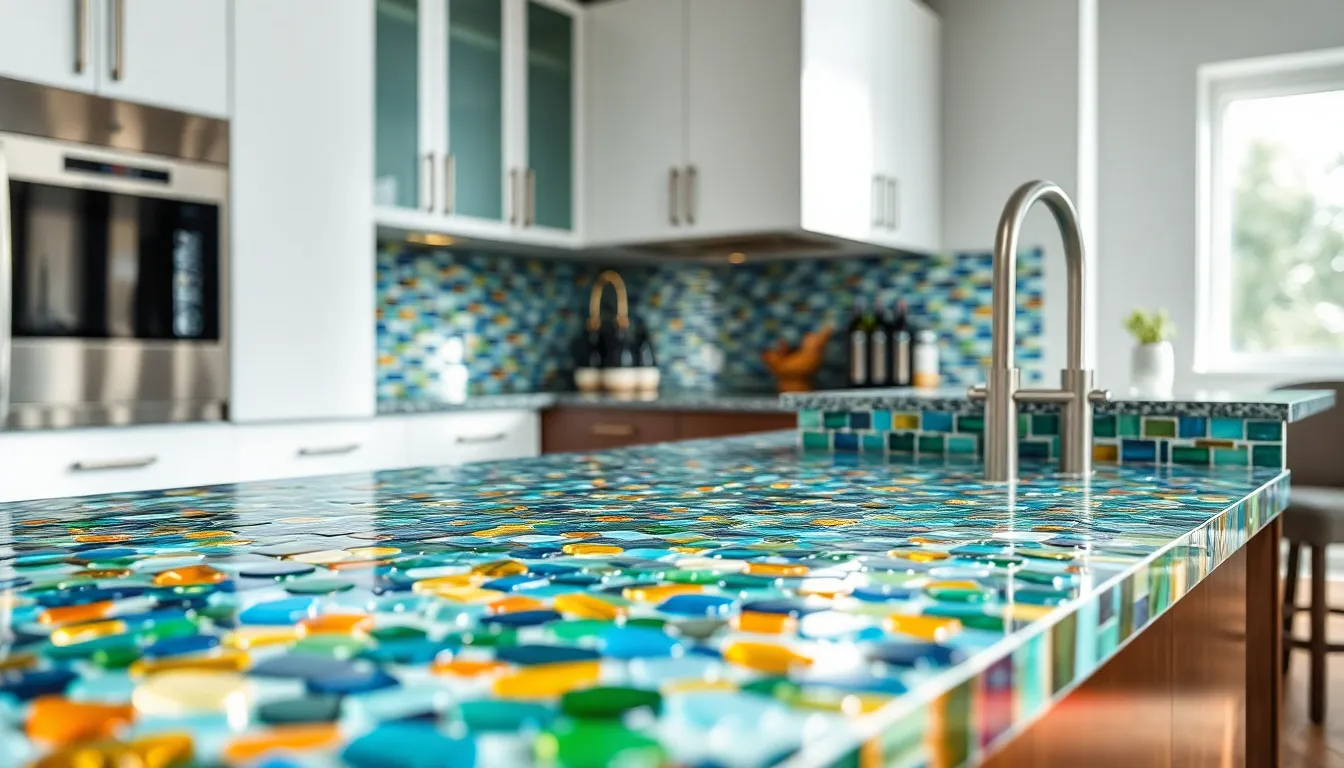
Moving beyond traditional materials, we discover an innovative solution that combines stunning aesthetics with environmental responsibility. Recycled glass countertops represent the perfect fusion of sustainability and style for modern kitchens.
Environmental Benefits and Sustainability
Choosing recycled glass countertops significantly reduces waste by repurposing glass that would otherwise end up in landfills. These surfaces are made from glass that would have been discarded, effectively conserving natural resources while creating beautiful kitchen surfaces.
Production processes for recycled glass countertops generate a lower carbon footprint compared to traditional materials like granite or marble. Energy consumption decreases substantially when we use recycled materials instead of mining and processing natural stone.
Demand for natural resources drops when homeowners select recycled glass options, saving energy and reducing environmental impact. We’re essentially giving new life to materials that have already served their initial purpose, creating a closed loop system that benefits our planet.
Color Combinations and Visual Appeal
Visual impact reaches new heights with recycled glass countertops that feature colorful glass chips in various shades and sizes. These surfaces create a captivating mosaic effect that’s impossible to replicate with traditional materials.
Light interaction becomes a design feature as glass chips catch and reflect illumination in fascinating ways. The unique shimmer changes depending on your viewing position, creating an ever-evolving visual experience throughout the day.
Aesthetic possibilities expand dramatically with recycled glass surfaces that offer one-of-a-kind looks for every kitchen. Color combinations range from subtle neutrals to bold, vibrant mixes that become the focal point of your culinary space.
Installation and Care Instructions
Installation requires a level surface and secure mounting using suitable adhesives for optimal results. Professionals typically apply sealants to protect the surface and ensure long-lasting performance.
Daily maintenance involves cleaning with mild soap and water to preserve the surface’s natural beauty. We recommend avoiding abrasive cleaners or scrubbers that can scratch the glass surface and diminish its appearance.
Durability characteristics include heat resistance and non-porous properties that make these countertops practical for kitchens and bathrooms. Proper care and maintenance ensure longevity and aesthetic appeal for years to come, making recycled glass an investment in both sustainability and style.
Creative Mixed Material Kitchen Countertops Ideas for Custom Designs
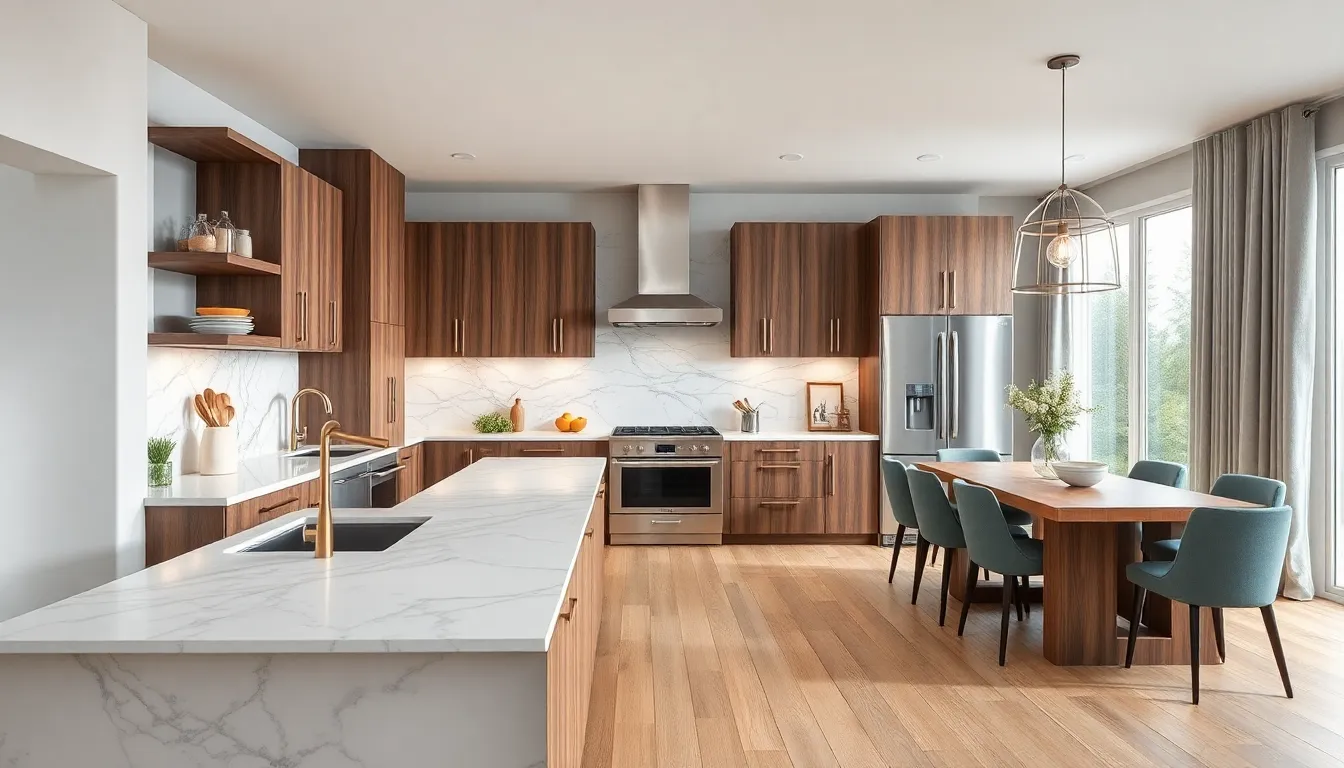
Mixing different countertop materials allows us to create truly personalized kitchen designs that reflect our unique style while maximizing functionality. We can achieve stunning visual impact by strategically combining materials that complement each other in both form and function.
Combining Different Surface Materials
Marble and Butcher Block combinations create elegant contrasts that blend luxury with warmth. We recommend using marble for prep areas where its cool surface excels at pastry work while incorporating butcher block sections for chopping and casual dining spaces.
Granite and Quartz pairings offer the perfect balance of natural beauty and modern practicality. Granite brings unique patterns and durability to high-use areas while quartz provides non-porous surfaces that require minimal maintenance in beverage stations or breakfast bars.
Concrete and Butcher Block mixtures deliver industrial chic aesthetics with cozy accents. We often see this combination work beautifully in loft-style kitchens where concrete serves as the primary surface and butcher block adds warmth around seating areas.
Stainless Steel and Marble-like Quartz designs merge professional functionality with timeless elegance. This pairing works exceptionally well in cooking zones where stainless steel handles heat exposure while quartz maintains visual continuity throughout the space.
Zoning Techniques for Functional Areas
Preparation zones benefit most from durable and easy-to-clean materials like quartz or granite that withstand daily chopping and mixing activities. We position these surfaces near sinks and storage areas for maximum efficiency.
Cooking areas require heat-resistant materials such as granite or concrete that won’t suffer damage from hot pots and pans. These materials maintain their integrity even with frequent exposure to high temperatures.
Dining zones call for more aesthetic materials like butcher block or marble that create inviting spaces for family meals and entertaining. We choose these surfaces for their visual appeal and comfortable interaction qualities.
Beverage stations work best with low-maintenance materials that resist stains and moisture from coffee makers and wine storage. Quartz surfaces excel in these applications due to their non-porous nature.
Professional Design Considerations
Balance and contrast principles guide our material selections to ensure visual cohesion throughout the kitchen space. We create enough distinction between materials to define different zones while maintaining overall harmony.
Color coordination strategies help us match countertop materials with existing accent colors in cabinetry, backsplashes, and hardware. This approach creates seamless transitions between different surface areas.
Functionality assessments drive our decisions about which materials work best in exact zones based on durability and maintenance requirements. We evaluate each area’s usage patterns before making final material selections.
Maintenance compatibility influences our recommendations since different materials require varying care routines. We ensure that our clients understand the upkeep requirements for each surface type in their mixed material design.
Conclusion
Choosing the perfect kitchen countertop eventually comes down to understanding your lifestyle needs and design preferences. We’ve explored how each material offers unique benefits—from granite’s timeless elegance to recycled glass’s eco-friendly innovation.
The key is finding the right balance between functionality durability and visual appeal that works for your exact space. Whether you’re drawn to traditional materials or excited about mixed-material designs your countertop choice will significantly impact your kitchen’s overall success.
Remember that the best countertop isn’t necessarily the most expensive one—it’s the one that seamlessly integrates with how you actually use your kitchen while reflecting your personal style preferences.
Frequently Asked Questions
What are the most popular kitchen countertop materials?
The most popular kitchen countertop materials include granite, quartz, marble, butcher block, concrete, laminate, and stainless steel. Each material offers unique benefits in terms of durability, maintenance, and aesthetic appeal. Granite and quartz are top choices for their combination of beauty and functionality, while laminate provides excellent budget-friendly options.
How much do granite countertops typically cost?
Granite countertop costs vary depending on the quality, color, and installation complexity. Basic granite starts around $40-60 per square foot installed, while premium exotic varieties can reach $100-200 per square foot. Additional costs include edge treatments, cutouts for sinks, and professional installation, making it important to get detailed quotes from contractors.
Are quartz countertops better than granite?
Quartz countertops offer several advantages over granite, including non-porous surfaces that don’t require sealing, consistent patterns, and superior stain resistance. However, granite provides unique natural beauty and heat resistance. The choice depends on your priorities: quartz for low maintenance and uniformity, granite for natural character and heat tolerance.
What is the most low-maintenance countertop material?
Quartz and stainless steel are the most low-maintenance countertop materials. Quartz requires only daily cleaning with mild soap and water, never needs sealing, and resists stains and bacteria. Stainless steel is equally easy to maintain, requiring simple cleaning with appropriate cleaners and offering excellent hygiene properties for busy kitchens.
Can I install countertops myself?
DIY installation is possible for some materials like laminate and butcher block, but most countertops require professional installation. Granite, quartz, and marble need specialized tools, experience, and strength for safe handling. Concrete countertops can be DIY-friendly with proper preparation, while stainless steel typically requires professional fabrication and installation.
How do I maintain marble countertops?
Marble countertops require gentle care to maintain their beauty. Clean daily with pH-neutral cleaners, seal regularly every 6-12 months, and immediately wipe up acidic spills like lemon juice or wine. Use cutting boards and trivets to prevent scratches and etching. Despite requiring more maintenance, proper care keeps marble looking stunning for decades.
What are recycled glass countertops made of?
Recycled glass countertops are made from post-consumer and post-industrial glass combined with cement or resin binders. The glass is crushed into various sizes and mixed to create colorful, mosaic-like surfaces. This eco-friendly option diverts waste from landfills while creating unique, durable countertops that offer excellent stain and heat resistance.
Can I mix different countertop materials in one kitchen?
Yes, mixing different countertop materials is an excellent design strategy that creates functional zones while adding visual interest. Popular combinations include marble for baking areas with butcher block for prep zones, or granite with stainless steel accents. Consider maintenance compatibility, color coordination, and functional requirements when planning mixed-material designs.
How long do different countertop materials last?
Countertop lifespan varies by material and maintenance. Granite and quartz can last 50+ years with proper care, while marble typically lasts 20-30 years. Butcher block requires refinishing every 5-10 years but can last decades. Laminate lasts 10-20 years, concrete can last 30+ years, and stainless steel can last a lifetime with minimal maintenance requirements.
What countertop material is best for busy families?
For busy families, quartz countertops offer the best combination of durability, low maintenance, and style. They resist stains, don’t require sealing, and handle daily wear exceptionally well. Alternatively, laminate provides budget-friendly durability, while stainless steel offers professional-grade performance with easy cleanup, making both excellent choices for high-traffic family kitchens.







